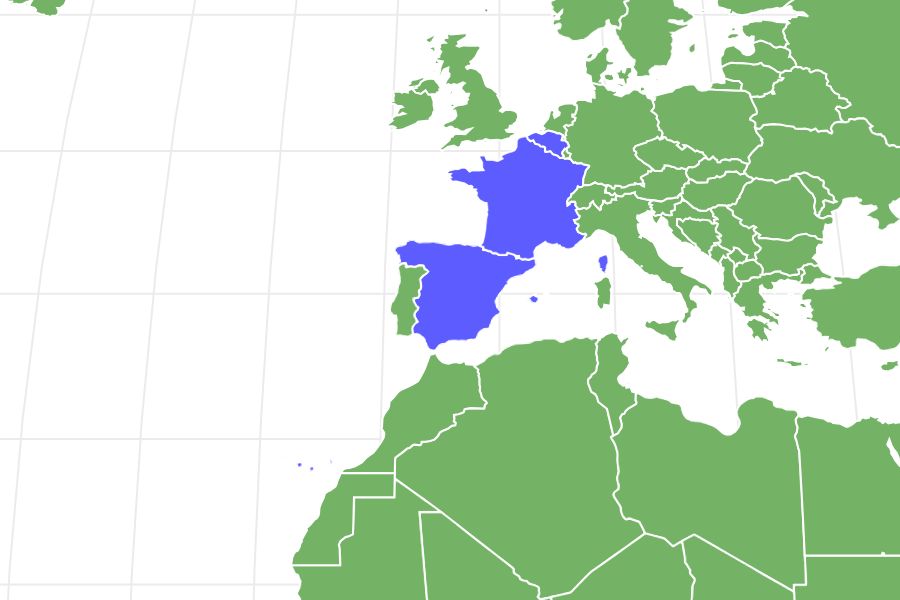Papillon
Canis lupus
Originally called the Toy Spaniel, the Papillon is one of the oldest breeds in the toy group. They can be found in artwork dating back to the 16th century.
Advertisement
Papillon Scientific Classification
- Kingdom
- Animalia
- Phylum
- Chordata
- Class
- Mammalia
- Order
- Carnivora
- Family
- Canidae
- Genus
- Canis
- Scientific Name
- Canis lupus
Read our Complete Guide to Classification of Animals.
Papillon Conservation Status
Papillon Facts
- Name Of Young
- puppy
- Fun Fact
- Originally called the Toy Spaniel, the Papillon is one of the oldest breeds in the toy group. They can be found in artwork dating back to the 16th century.
- Most Distinctive Feature
- the ears
- Temperament
- alert and friendly
- Diet
- Omnivore
Papillon as a Pet:
- General Health
- Energy Level
- Shedability
- Trainability
- Intelligence
- Tendency to Chew
- Size
- Family and kid friendliness
- Yappiness / Barking
- High
- Separation Anxiety
- High
- Preferred Temperature
- Average climate
- Exercise Needs
- Moderate
- Friendly With Other Dogs
- High
- Pure bred cost to own
- $800-$3,000
- Dog group
- Toy
- Male weight
- - lbs
- Female weight
- - lbs
This post may contain affiliate links to our partners like Chewy, Amazon, and others. Purchasing through these helps us further the A-Z Animals mission to educate about the world's species.
View all of the Papillon images!
Originally called the Toy Spaniel, this is one of the oldest breeds in the toy group. They can be found in artwork dating back to the 16th century.
History And Origin
At first called the Toy Spaniel, the Papillon, which originated in France, is one of the oldest breeds of toy spaniel that has provided companionship for centuries. The dog was known as a toy spaniel early on as the breed was developed from the miniature spaniel and can be traced back to the early 16th century due to being featured in works of art found throughout Western Europe. The name Papillon was developed in reference to the breed’s distinctive ears and mask which resemble a butterfly. Papillon is French for butterfly.
See all of our expert product reviews.
Sweet and playful, the Papillon has many fans as a companion dog. The breed also does well in competitions such as obedience and agility, due to its attentive nature and eagerness to please. The breed’s popularity and affectionate nature make it a popular choice for backyard breeders. Selecting a pup from a reputable breeder or rescue ensures you get a healthy dog with the personality Papillons are known for.
The Different Types Of Papillon Mixes
There are several different breeds the Papillon is frequently crossed with to create special “designer” dog breeds. The Paperanian, for example, is a cross between the Papillion and Pomeranian. The Chion, is a mix between the Papillon and Chihuahua. A cross between a Poodle and Papillion is known as a Papipoo, while the mix of a Papillon with a Maltese is called the Papitese.
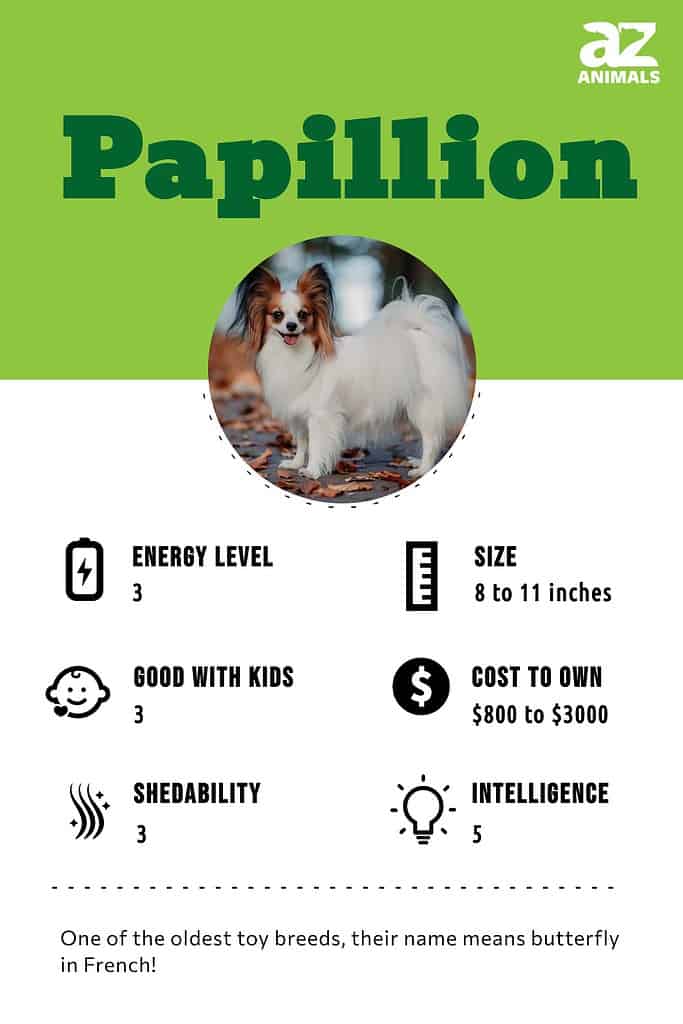
3 Pros And Cons Of Owning A Papillon
| Pros! | Cons! |
|---|---|
| Generally healthy | Doesn’t like to be left alone |
| Excellent companion | Can be more energetic than anticipated |
| Easy to train | Tendency to bark |
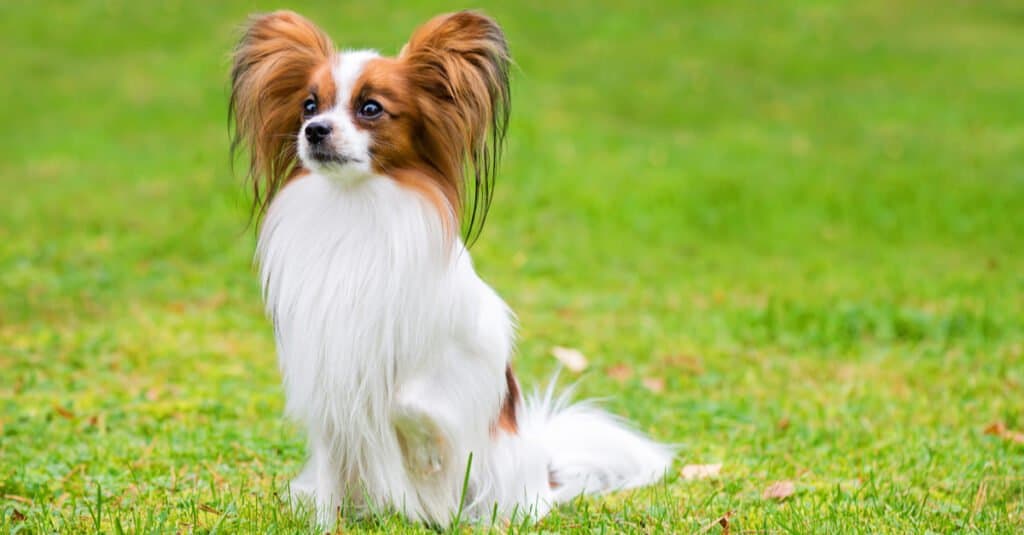
©Anna Maloverjan/Shutterstock.com
Size And Weight
The Papillon is a small breed, fitting firmly into the toy family. The males and females are similar in size and weight, with the males occasionally being slightly taller and heavier.
| Weight (Male): | 9 pounds |
| Weight (Female): | 8 pounds |
| Height (Male): | 11 inches |
| Height (Female): | 10 inches |
Common Health Issues
The breed is generally healthy, although, just as with any dog, there are a few health conditions they are predisposed to. Luxating patellas, when the kneecap slips out of place, and progressive retinal atrophy, are both conditions your veterinarian will watch for. Like many small dogs, the breed may also develop dental problems. Taking care of their mouth, with regular brushing from a young age, can help keep their mouth and teeth healthy.
Health and Entertainment for your Papillon
See all of our expert product reviews.
Temperament
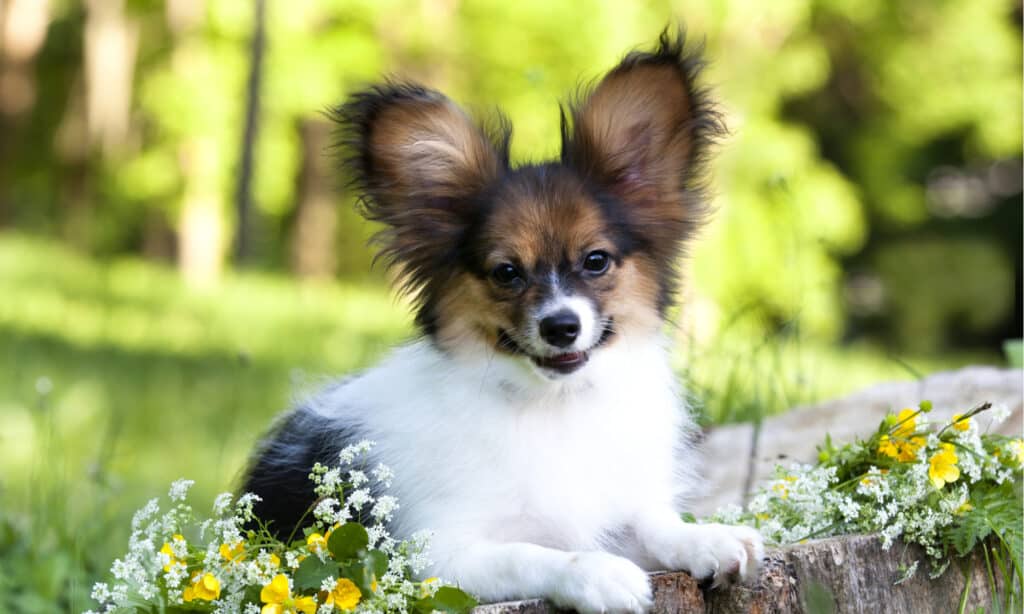
Papillons are friendly, alert, and happy.
©Liliya Kulianionak/Shutterstock.com
The breed’s temperament is one of its defining traits. Happy-go-lucky, friendly, alert, and always engaging, the Papillon has never met a stranger. Shyness or aggressiveness are considered major faults in the breed.
How To Take Care Of Papillons
These dogs are generally easy to care for. Because the dog is so low-maintenance, it is easy to get away with providing less attention than they need. Papillons thrive on mental stimulation and love activity. Spending time each day on a walk, teaching tricks, or otherwise engaging with your pup is important for his mental health.
The Best Dog Food For Papillons
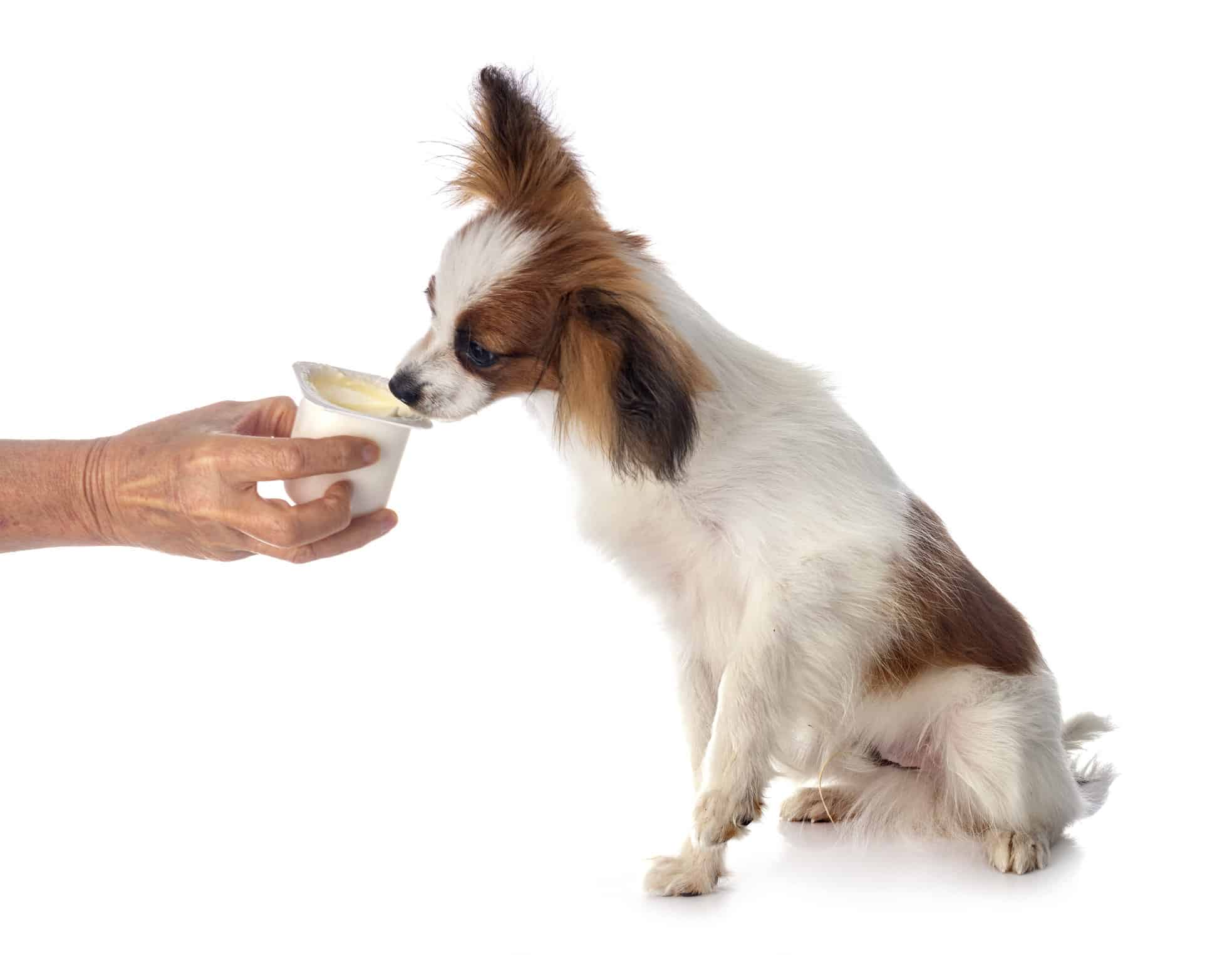
Always monitor your dog’s diet and be sure not to overfeed them.
©iStock.com/cynoclub
It is important to keep an eye on your pup’s diet. Their small size makes it easy to overfeed them, and obesity can lead to health issues. Puppies should have their meals split into at least three servings each day. By the time the Papillon reaches six months, he will do well on two meals a day, which should be maintained throughout his lifespan.
It is always a good idea to be careful when feeding any dog table scraps or treats, but with any small breed, it is even more so. It takes very little “people food” to upset the nutritional balance of dog food as well as the pup’s stomach.
To prevent any dental problems, the best way to go is dry kibble rather than wet food.
So, our favorite option at A-Z Animals as the best dog food for Papillons is Eukanuba Adult Small Bites Dry Dog Food.
This chicken-based dog food is ideal for Papillons because it has the beta-carotene they need for long-lasting clear vision and healthy eyes. It also contains glucosamine and chondroitin, which fortify the joints and encourage the building of lean muscle. What’s more, the crunchy kibble is specially designed in a strategic shape to minimize plaque and tartar for sparkling teeth.
Here’s where you can buy Eukanuba Small Bites on Chewy and Amazon.
- Small bite blend suited for dogs with smaller jaws
- DHA and antioxidants for brain health
- High protein to provide energy
- Supports lean muscles and healthy joints
Maintenance And Grooming
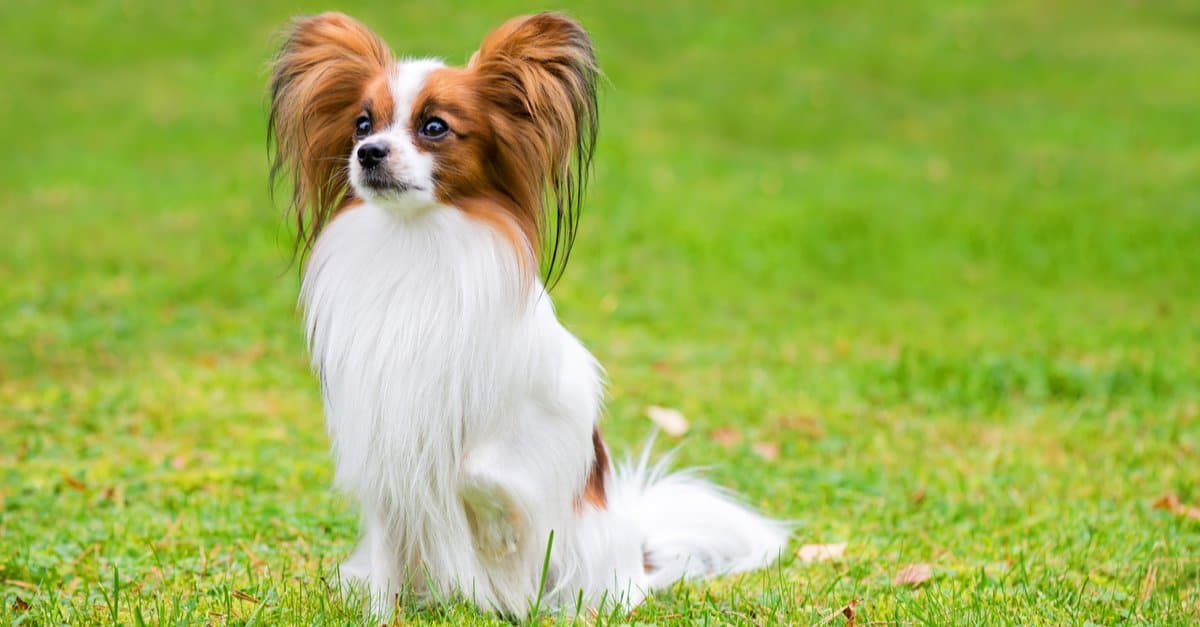
Papillons do not shed a lot but they do need their ears cleaned regularly.
©Anna Maloverjan/Shutterstock.com
When you see all the long hair on the Papillon, you may assume they require a lot of care. Surprisingly, as long as you groom your pup frequently, it isn’t a big job. The breed doesn’t shed excessively, so a quick brush with a pin brush or steel comb a few times a week to prevent tangles from forming is all it takes to keep your pup looking good.
The breed does need its ears cleaned out on a regular basis. Wiping the ears with a damp cloth once a week should be enough to keep the ears healthy and your pup will quickly get comfortable with the routine.
Training
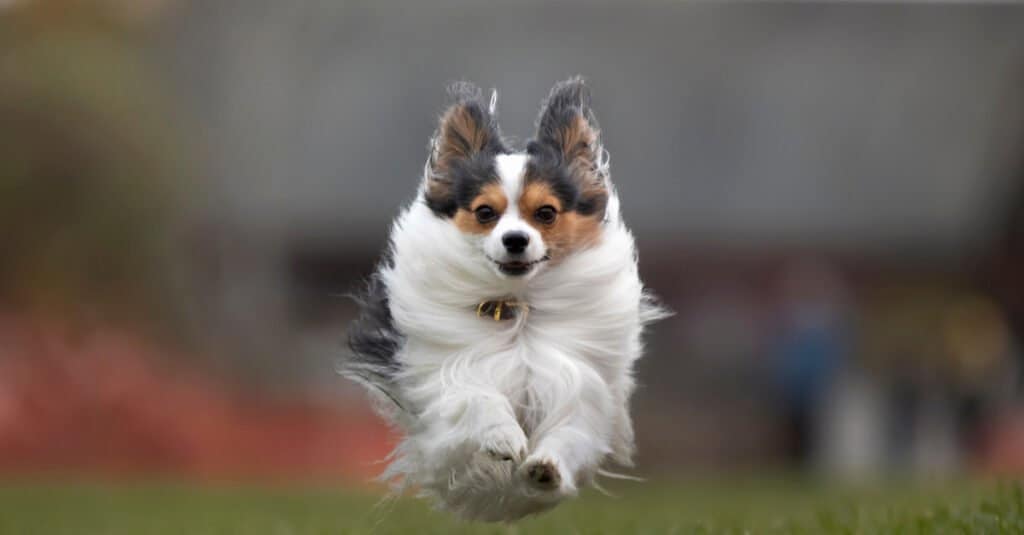
Papillons are easy to train as long as you remain patient.
©Elizabeth Dee/Shutterstock.com
Training is easy and enjoyable as long as you are patient and consistent. They are small dogs, so it is important not to be loud or aggressive when dealing with them. If they are frightened it will be much more difficult for them to learn. With positive training, the Papillon enjoys learning new skills and tricks, and will frequently show them off for attention.
Exercise
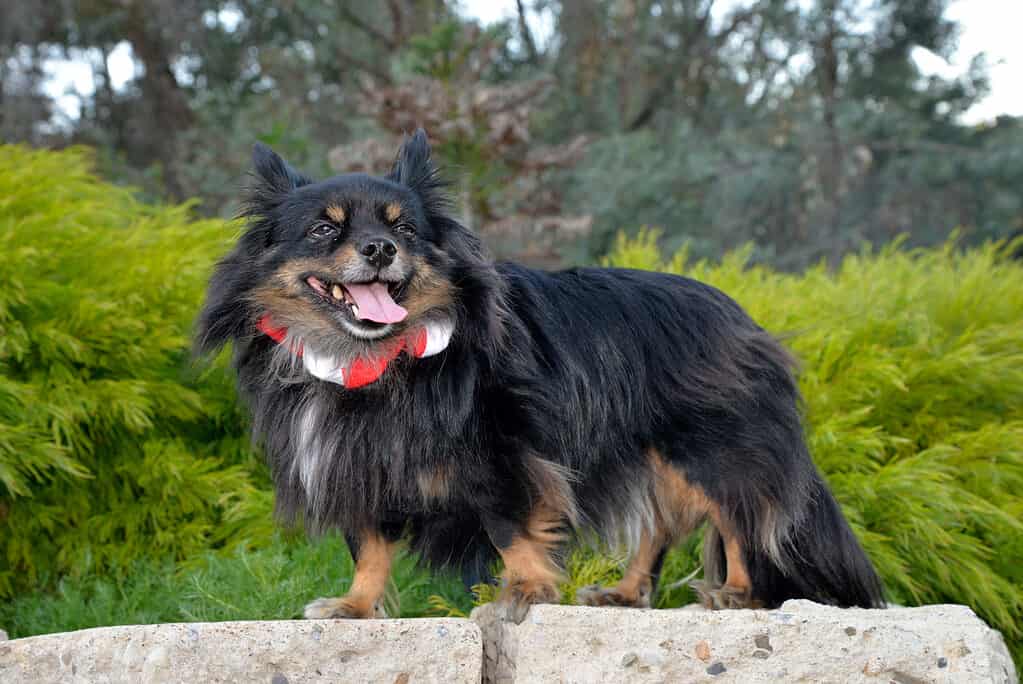
The papillon is a high-energy breed and loves to exercise.
©Steve Bruckmann/Shutterstock.com
The breed is high-energy and loves to be on the move. Their small size makes it easy to provide exercise, they are often as happy chasing a ball in the living room as they are heading outside. Keep in mind, just because your Papillon is willing to do something, doesn’t mean it should. Long hikes, jogging, and other rigorous exercises are too intense for the pup.
Puppies
These dogs typically have small litters, sometimes only giving birth to one puppy. Three puppies are the average size of their litter. Toy breeds often need assistance during delivery. Their narrow pelvis can make delivery a challenge, and the veterinarian may feel that a C-section is the safer choice.
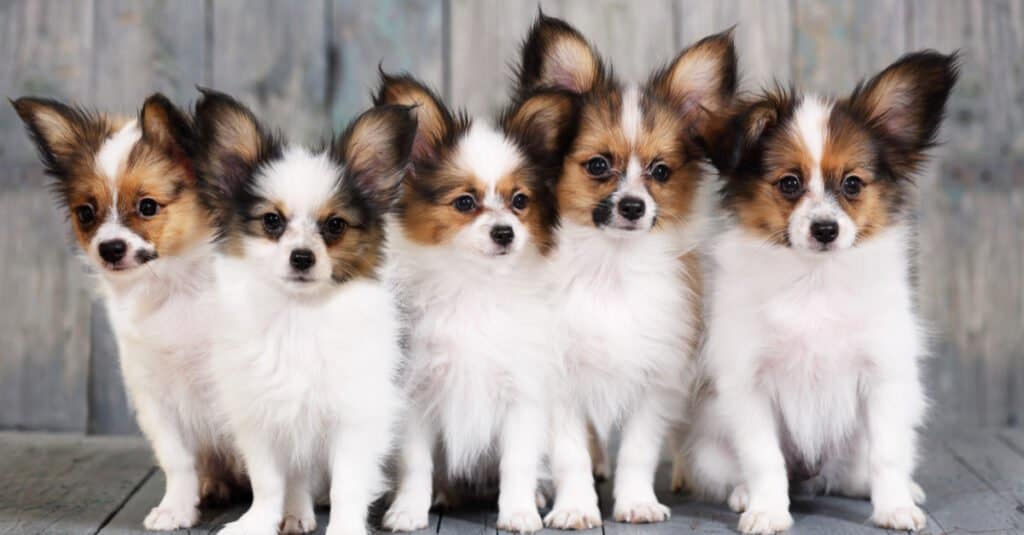
©Malivan_Iuliia/Shutterstock.com
Papillons And Children
Children and Papillons can get along well and be best friends, but it is important to be cautious. The Papillon is a bright, attentive breed. Having a child around provides the activity and engagement he craves. However, the breed is small and somewhat delicate. It is important that any children around the pup know that they need to be gentle with their play, and children and dogs should always be supervised.
Dogs Similar To The Papillon
As endearing as the breed is, it isn’t the best choice for everyone. There are several similar breeds that may be a better fit for your family.
- Toy Fox Terrier– Playful and active, but his short coat and pricked ears are low-maintenance.
- English Toy Spaniel- Affectionate and willing to play, but lower energy and more content to hang out on the couch
- Shih Tzu– Playful but always happy to cuddle, the Shih Tzu is a wonderful companion. This breed is also well suited for agility and obedience competitions.
Famous Papillons
The Papillon has been a favored choice for royalty throughout history. They were kept in the homes of King Henry II and Henry III as well as Marie Antoinette. In modern times, singer Christina Aguilera and actor George Takei own the breed.
Popular Names For The Papillon
Many popular names for the breed play off of their French names, such as:
- Dax
- Leon
- Aubin
Other popular choices include:
- Domino
- Vulcan
- Chipper
Papillon FAQs (Frequently Asked Questions)
How much does the Papillon cost to own?
Purchase price averages between $750 and $1500. You should also plan to spend money on vaccinations as well as some basic supplies, such as a crate and leash. Because the Papillon is a small breed, he doesn’t cost much to feed. The breed is overall very healthy, so they are relatively affordable to care for.
If the initial price is out of budget, consider contacting a reputable rescue. They often have dogs of all ages looking for foster care or a permanent home.
Is the Papillon good with kids?
They are good with kids, but kids need to be shown how to play with the dog. The small breed is exuberant and loves attention, so it is up to the child and supervising adults to keep them playing safe. Spending time together from a young age is possible, but kids may need reminders to be gentle.
How long does the Papillon live?
The average lifespan is 12 to 17 years.
What is a Papillon?
The breed is personable, active, and attentive. They are a toy breed, love to be with their family, and are easy to train. They are an ancient breed, with their history dating back more than 700 years. Bred for the purpose of companionship, they get along well with people and other pets.
What does a Papillon dog look like?
The breed comes in nearly any color, although they are always particolored, with patches of white on the body. The ears are any color other than white, and that color extends across the forehead, enhancing the butterfly-like appearance when looking at the dog from the front. They can have white on their face in the form of a narrow blaze or spot above the nose, but white should not be the primary color on the head.
The color combinations most frequently seen in the breed include white, black and tan, white and black, white and red, white and lemon, and white and sable.
Do Papillon dogs bark a lot?
They can be very noisy. Training your pup to be quiet on command and providing plenty of physical and mental stimulation is the best way to discourage this behavior.
How much does a Papillon dog cost?
They range in price from $750 to $1500. For a more affordable option, consider visiting a rescue.
Do Papillon dogs like to cuddle?
The breed was developed for the purpose of companionship, and their owners find that the dog typically wants to do whatever the owner is doing. If that is sitting on the couch, they are ready to cuddle. If the owner is in the kitchen, expect to see the pup sitting close by.
Are Papillons aggressive?
The breed is not known to be aggressive. As with any dog, each one is an individual. You can encourage friendliness and attentiveness that comes naturally to the breed by socializing it from a young age.
Are Papillon dogs clingy?
The breed was developed for the purpose of companionship, so it is understandable that they enjoy being around people. They are prone to developing separation anxiety if left alone for long periods. One way to ease this behavior is by having another pet. Another dog or cat in the house helps to ease his loneliness if he will need to be left alone for long periods on a regular basis.
What are the differences between a Pomeranian and a Papillon?
The main differences between Pomeranians and Papillons are color, behavior, appearance, size of ear, and coat type.
Thank you for reading! Have some feedback for us? Contact the AZ Animals editorial team.
Sources
- American Kennel Club, Available here: https://www.akc.org/dog-breeds/papillon/
- Pet MD, Available here: https://www.petmd.com/dog/breeds/c_dg_papillon

